Expert Guide: Setting Up VDI for BPO Operations
18 Mar 2024 By: Michael Kansky
Updated
The COVID-19 pandemic has led to the popularity of work from home all over the world and has increased the importance of virtual desktop infrastructure. Remote management of PCs, enforcement of cybersecurity policies and compliance have become difficult for companies, particularly, with workers using their own devices. A perfect example is yours truly HelpSquad BPO company that has more than 300 employees who started working remotely literally overnight. Although at first the company provided laptops and chrome books to its employees, it quickly became overwhelmed with the remote management of that infrastructure.

In the search for a resolution, we selected Azure Virtual Desktop and Amazon Workspaces Web, two solutions that provided affordable and efficient remote IT management solutions, as well as HIPAA and PCI compliance. This article is aimed at providing the comparison between these two choices, detailed setup instructions for each, and hands-on recommendations on selecting the system that suits your organizational needs. The goal is to provide the experience and valuable knowledge we gained during setup.

Amazon Workspaces should not be mixed up with Amazon Workspaces Web. Although the names may seem alike, Amazon Workspaces is more like Azure Virtual Desktop in functionality than Amazon Workspaces Web. The article is mainly centered on the contrast between Amazon Workspaces Web and Azure Virtual Desktop.
This article is aimed to help BPO companies or organizations desiring optimal IT operations for remote staff. If you have ongoing IT problems, employee security incidents, non-performing PCs, continuous employee reported issues with internet connection, or you need to enable remote workers to access client systems that are limited to US/Canada IP addresses, then this piece is for you.
What is Azure Virtual Desktop
Azure Virtual Desktop, also known as Windows Virtual Desktop, is a Microsoft Azure service for virtualizing Windows operating systems, which clears the way for use of virtualized applications and remote desktops. The platform allows users to get a Windows virtual desktop anywhere in the world and on any device making them flexible. It eliminates the requirement of a physical desktop and provides security, scalability and simplicity in its operation and more importantly remote IT management.
Azure Virtual Desktop suits businesses of various sizes. Mobility and accessibility is an advantage to the companies that have remote or travelling employees. Similarly, companies with high-security requirements love Azure Virtual Desktop as it allows secure remote access to files and apps therefore reducing the possibility of data breach. Economical IT solution seekers also gain, because Azure Virtual Desktop reduces hardware costs and the need for high maintenance on-premises infrastructure.
What is Amazon Workspaces Web
Amazon WorkSpaces Web is a low cost, fully managed, Linux-based service, intended to enable secure browser access to internal sites and software as a service (SaaS) applications from standard web browsers, without the need to run appliances, maintain infrastructure, install special client software, or deploy virtual private network (VPN) connections. However, for added security, you might consider using a VPN, which is legal in most countries.
WorkSpaces Web can be used to secure a web browser-based productivity environment, allow safe browsing from high-security networks, or facilitate lightweight bring-your-own-device (BYOD) access for browser-only resources. A majority of the workloads are moving away from a traditional desktop environment into SaaS applications or custom built internal websites. Consequently, the browser is now a key productivity tool. The present solutions to secure the browser traffic are too permissive, costly, complex, or all the above. To combat these pain points, WorkSpaces web was tailor made and provides a simple way of giving access to web content with associated risks of data exfiltration or unsafe connections with remote devices.
Azure Virtual Desktop vs Amazon Workspaces Web services
Azure Virtual Desktop and Amazon Workspaces Web are two very different web services available for management of virtual infrastructure. Their main difference that distinguishes them is the utility they offer. Azure Virtual Desktop is fully-featured, which means you can install and operate fully-featured applications just like on your physical desktop at home(for example Adobe Photoshop). It offers a complete set of functionalities to do activities just like on a personal computer. This is very helpful for organizations where their employees use software applications that have to be installed to operate.
In contrast, Amazon Workspaces Web offers a safe chromium web browser. Using this service, companies would be able to set rules for their remote workers to have access to some websites, bookmarks, extensions, printer and clipboard access, and internet gateway location. This practically confines the staff to only using the web applications they need to accomplish their usual duties while getting rid of redundant/insecure ones. Basically, it is ideal for companies, which workers mainly use web based applications.
In terms of pricing, there is also a significant difference between the two. Generally, Azure Virtual Desktop is estimated at $40.00 per user per month. Conversely, the Amazon Workspaces Web comes at a cost of just $7 per user per month.
Security, HIPAA and PCI compliance
Both Azure Virtual Desktop and Amazon Workspaces Web offer similar accessibility and security controls for remote infrastructure management and convenience, while ensuring compliance with HIPAA and PCI regulations.
It is very important to note that Amazon Workspaces Web has a pretty annoying limitation. You may only configure one Web Portal per Region and can only have 25 simultaneous user sessions per portal. So if you are a large organization requiring more than 25 users connected at a time, you will need to configure several web portals, one per region or start a new AWS account for each of the 25 user blocks. Or simply said, Amazon Workspaces Web is not for you and your best option is Azure Virtual Desktop. Here is a list of all Amazon Workspaces Web limitations.
| Name | Default | Description |
|---|---|---|
| Number of maximum concurrent sessions per web portal | Each supported Region: 25 | The maximum number of concurrent sessions for a Amazon WorkSpaces Web portal in this account in the current Region. |
| Number of web portals | Each supported Region: 1 | The maximum number of Amazon WorkSpaces Web portals in this account in the current Region. |
| Number of browser settings | Each supported Region: 3 | The maximum number of Amazon WorkSpaces Web browser settings in this account in the current Region. |
| Number of certificates per trust store | Each supported Region: 100 | The maximum number of certificates in an Amazon WorkSpaces Web trust store in this account in the current Region. |
| Number of identity providers per web portal | Each supported Region: 1 | The maximum number of identity providers for an Amazon WorkSpaces Web portal in this account in the current Region. |
| Number of network settings | Each supported Region: 3 | The maximum number of Amazon WorkSpaces Web network settings in this account in the current Region. |
| Number of trust stores | Each supported Region: 3 | The maximum number of Amazon WorkSpaces Web trust stores in this account in the current Region. |
| Number of user settings | Each supported Region: 3 | The maximum number of Amazon WorkSpaces Web user settings in this account in the current Region. |
As a Business Process Outsourcing (BPO) Company, we aimed to provide regulatory compliance, simplify user and system administration, develop strategic regional infrastructure that allows for easy scaling and management while providing an affordable price. Our operation model does not require our users to run CPU intensive or memory-aggressive applications. In contrast, they only log on to our client’s systems for services such as customer services or account management.
To achieve the said objectives, it was determined that we did not need the dedicated desktop service offered by Windows 365 Cloud PC. Our needs are perfectly fulfilled by tools such as Azure Virtual Desktop or Amazon Workspaces Web Services. These platforms are affordable and provide functionalities we need without unnecessary frills, helping us in delivering vital services for our customer effectively and efficiently.
Azure Virtual Desktop Step by step setup
If you have not yet created your Microsoft Azure account, start your trial here.


Step 1: Active Directory (Microsoft Entra ID)
Active Directory is needed to manage devices and users in your Azure account. The choices are traditional active directory or new and improved Microsoft Entra ID. Entra is easier to setup and manage and does not require additional devices to be configured within your Azure account as in case of Active Directory, so I prefer Microsoft Entra ID.
If you would like to learn more about Microsoft Entra ID which is an extemely powerful system for managing and streamlining users and devices, the below is an excellent introduction.
Let’s continue setup. In “Search resources, documents, etc” search box on top of the Azure Portal find “Microsoft Entra ID” and navigate to it.
Create new Microsoft Entra ID, use your domain for primary domain, you will need to add a TXT record to your domain’s DNS to verify it during the setup.
I personally like to use subdomain for primary domain name here i.e. local.domain.com
The reason for this is to make sure virtual desktop users are taken to our website and not active directory domain when they type domain.com in a browser. Using subdomain for Entra ID will isolate it from the main website domain.
Once Microsoft Entra ID tenant is established, it would be a great idea to add a new internal admin user. This is something I learned the hard way. If you only have one admin user on the account and you forget your credentials, lose your phone with MFA codes, you will have a very hard time gaining access to your account. Having an additional admin, serves as a backup and additional trusted person with full access to your account.
- While inside Microsoft Entra ID, select users → create.
- Select Internal user.
- Enter name, email and other contact information you would like to provide.
- In Assignments select “add role” and add the user to Global Administrator role.
- in “Search resources” text box on top of the Azure Portal search and navigate to Azure Subscriptions.
- Select your subscription, select Access Control(IAM)
- Select Add → Role assignment → Privileged administrator roles
- Search for “Owner” and select it
- Switch to “Members” → Select Members, find the new user and add it.
- Select “Allow user to assign all roles” in Conditions.
- The click on “Review + assign” to complete the process.
You may now switch to groups and create all necessary groups for your organization. For example in our organization we had to create two groups:
HelpSquad-Agent to be used to assign CSRs(agents) to (low level of permissions)
HelpSquad-Supervisor to be used to assign shift supervisors to with higher level of permissions such as agent monitoring tools, desktop shadowing, access to clipboard, printers, etc.
Step2: Create resource group
A resource group is a logical container that holds related Azure resources. It helps you organize and manage resources together for a specific application, project, or environment. A resource group can be compared to a file folder in windows each resource group contains elements which are used in Azure.
Within a resource group, you can group resources such as virtual machines, storage accounts, virtual networks, and more. Inside the different groups you can manage access control (IAM) with RBAC Roles, apply policies (regulation e.x a policy which only allow the creation of virtual machines in a specific region, and track costs for a set of related resources.
- Search and navigate to “Resource Groups”.
- Create a new resource group.
- I like to name resources in Azure by prefixing them with an abbreviation of the item. For example I would name resource group “RG-COMPANYNAME”. This way I can always easily identify each resource by its name.
- To create resource group select active Azure subscription, name it and select the region. I would create everything in a region located as close as possibly to your end users. So if the users accessing your Azure implementation are all residing in New York for example, you will need to select East US region. Though resource group location is not as important as Host Pool and Virtual Machine Session Host (setup later), I still usually create everything in the same region.
- Once created, go to resource and select Access Control (IAM)
- Select Add → Role Assignment
- Select “Virtual machine User Login”
- In “Members” click on “Select Members” and select all groups you setup in Microsoft Entra ID.
- Select “Review and Assign” to complete the assignment.
- Select “Overview” within the resource group.
- In resources find resource with the type “Application Group” suffixed with DAG i.e. HS-ASIA-DAG. Select it.
- On Assignments click “Manage”
- Click “Add” and add the Microsoft Entra ID group(s) you created earlier.
Quick explanation of the Application Group:
An application group in Azure Virtual Desktop defines which applications are available to users. Applications group can be assigned to a user or group for a better management it is always recommended to assign security groups. It allows you to publish specific apps or desktops Application groups simplify app delivery and desktop management.
The default Application Group “*-DAG” is a Desktop Application Group which will be created when Host Pool create and is used for access the virtual desktop.
Step 3: Application Group
For remote app streaming we need to create a second application group of Type “RemoteApp” to provide applications for streaming.
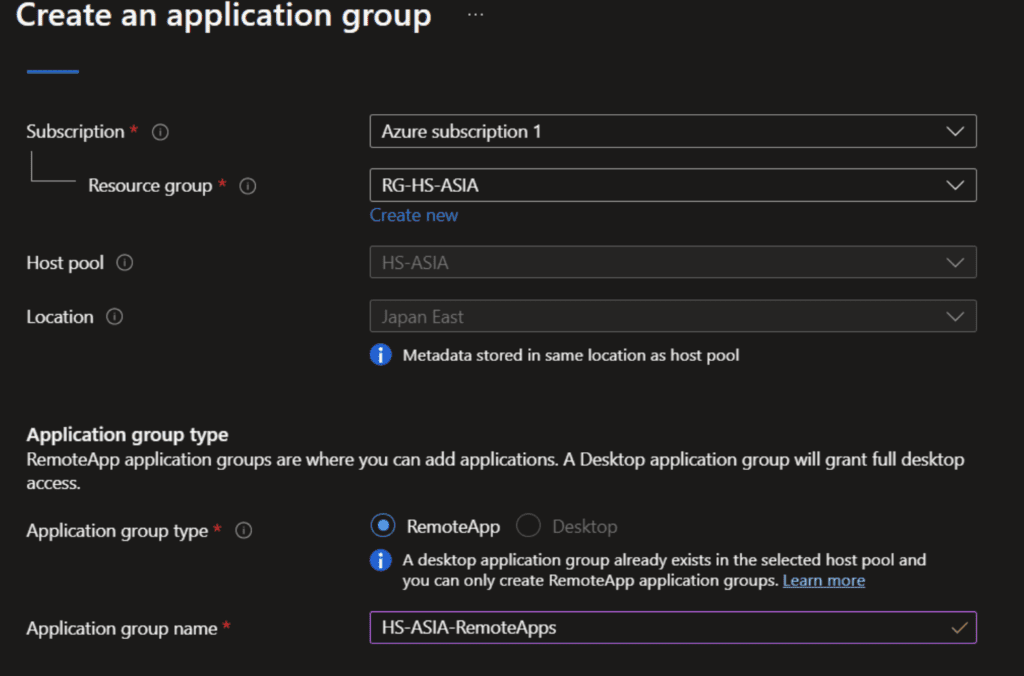

Think of application streaming as you would about Netflix. Services live Netflix streams movies and shows to your tv, RemotApp streams applications to your desktop. So users interact with a stream rather than actual apps on a computer.
For our case this was extremely useful as we did not want to give full desktop access to some of our users and only some applications on the virtual desktop. For those users workspace would only list applications they are allowed to use and nothing more.
After some basic configurations of the application group, we can add existing applications on the virtual machine for app streaming
In the list of applications all applications for streaming are listed.
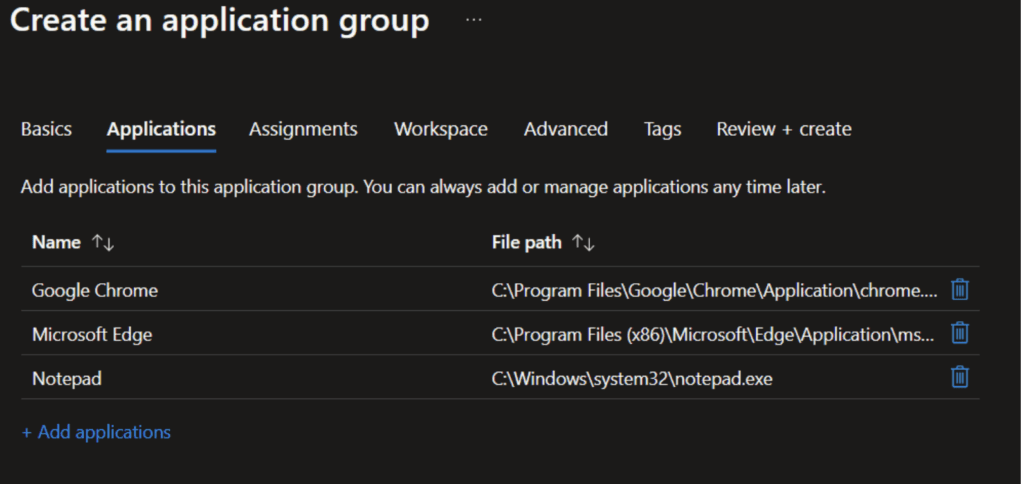

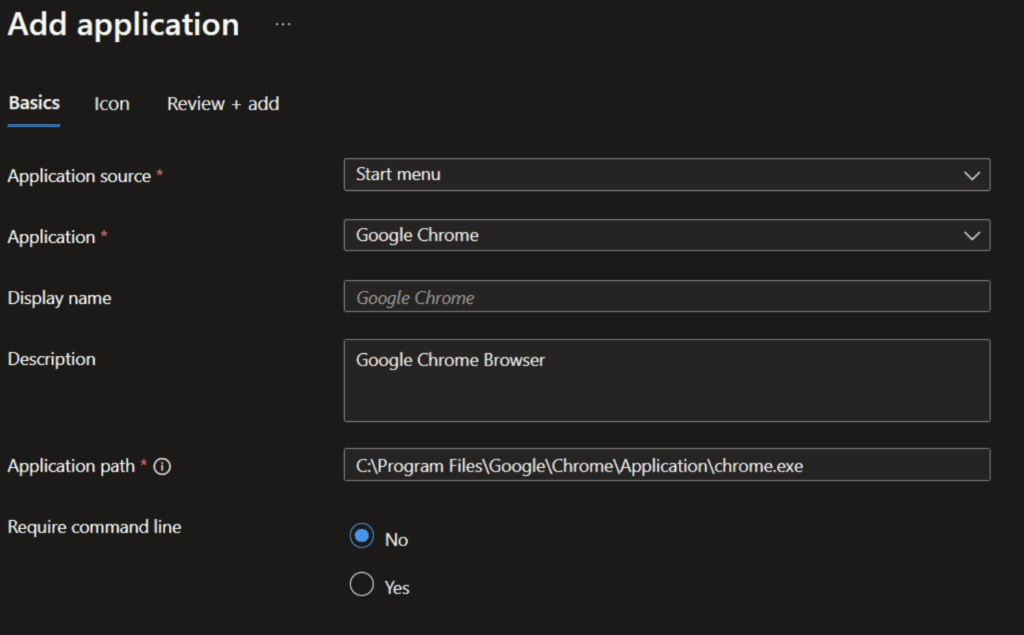

In the next step we can decide which security group will grant access for the app streaming.


By default, the remote app streaming group will be mapped to the existing workspace where the Application Group “*-DAG” is located.
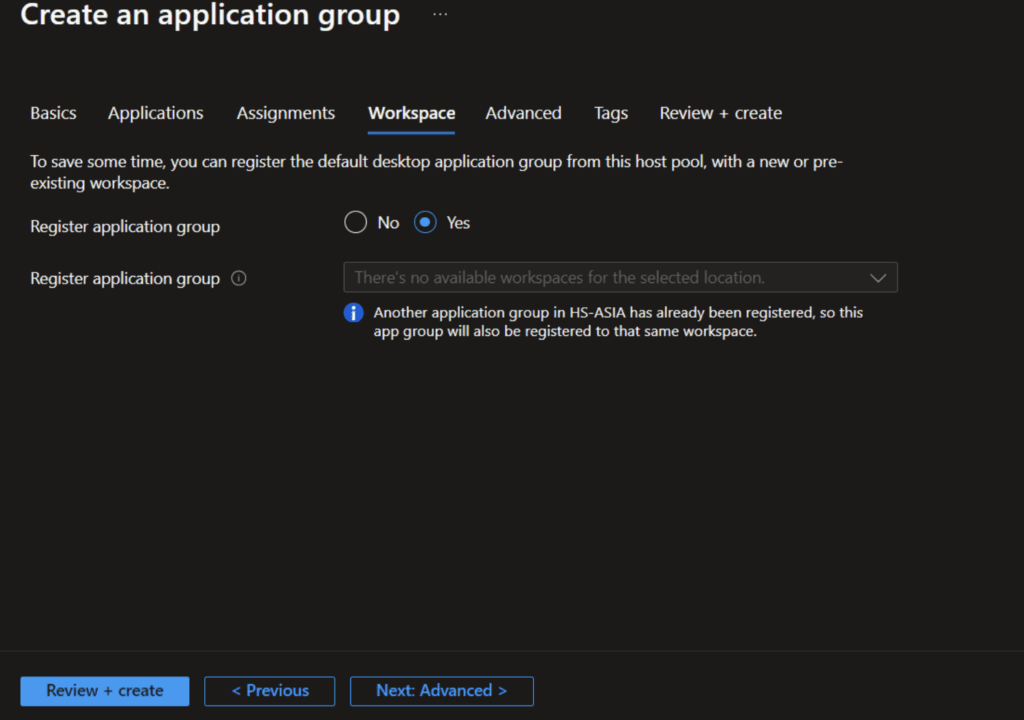

After the synchronization of the workspace with the new application in the remote desktop app the application on the session hosts can be used for app streaming.


In the taskbar a new icon of the application will be displayed for a better overview which application is local and which is streamed. Note a small remote desktop icon on streamed applications.


Step 4: Virtual Network
Azure Virtual Network is the foundation for your private network in Azure. Azure Virtual Network (a service instance) provides ability to virtualize multiple types of Azure resources, connect to the internet, and, optionally, on-premises resources.
- Search portal and navigate to Virtual Networks
- Create new Virtual network
- Place the new virtual network witih the Resource Group you created above
- Name it with vnet prefix i.e. vnet-asia.
- Select correct region you decided on to keep everything close to your end user.
- You do not have to change anything on the Security Tab. Leave defaults.
- On the IP addresses tab, delete the default subnet.
- Create two new subnets with the following IP address blocks:
Subnet-A : 10.0.1.0/24
Subnet-B : 10.0.2.0/24
Think about subnets as IP address area for the virtual machines. For example Subnet-A machines can communicate with each other to share network resources but not with Subnet-B PCs. This is so you can assign Virtual Desktops to different subnets when you need them to be isolated from each other. - Click “Review and Create” button to create your virtual network.
Step 5: Create and configure Host Pool
Azure Host Pool represents a collection of session hosts (Virtual Machines) that deliver desktops or applications to end-users. Host pools allow you to scale and manage virtual desktop infrastructure efficiently.


In the top bar search “Azure Virtual Desktop” and select it.
Click “Create a host pool” button.
Select active subscription, resource group you created in the previous step and name your host pool i.e. “HP-COMPANYNAME-USERTYPE”. Each host pool will have its own set of user permissions, so you will have a host pool created for each user type. For example for your standard users, supervisors, admins, etc.
Select Region, leave validation environment as “No”, preferred app group type as “Desktop” and select “Pooled” for host pool type.


A host pool can be one of two types: Personal, where each session host is allocated to a single user. Personal host pools enable end users to have dedicated desktops, which ensures environments for performance and data separation. Pooled, when user sessions can be load balanced to any session host in the host pool.
Because I am setting up this environment for customer service agents and virtual assistants to use desktops to access basic applications, mostly web, and accomplish basic tasks, I do not need to create Personal pool which is more expensive to operate as each user will need a desktop instead of one desktop shared between many users. I provide Max Session limit as 10 for now, which means 10 users maximum can be on one desktop at the same time. When 11th user tries to connect, the Azure will spin up a new desktop for the new user to connect to, which also will have 10 user limit maximum. We will go over that setup (auto scaling) later below. Think about it as an automatic load balancing for your VMs.
Now with Basic setup of the host pool completed, we move to “Virtual machines” tab.
Name prefix I usually provide as regionname-vm, i.e. asia-vm.
Select virtual machine location. Again this should be the closest to your end users.
The VM image you select is very important. It depends on how many users will be accessing your VMs at the same time.
You can always upscale or downscale your VMs.
Select Number of VMs for this host pool. Let’s start with 2 for now. As the number of users grows for your organization, all you will need to do is increase this number to provide more VMs within your host pool to service more sessions.




For OS Disk Type select Premium SSD.
Select Virtual network you created above.
Select one of the Subnets you created above.
For Availability options select “No infrastructure redundancy required”
For Domain to join select Microsoft Entra ID.
Provide username and password for virtual machine administrator account. Do not worry about forgetting the password, you may always reset it. This account will be able to login and administer all of the VMs in this host pool.


Next, we go to Workspace tab.
A workspace is a container for Azure Monitor and Azure Security Center data. It provides a centralized place to collect, analyze, and visualize telemetry data from various Azure resources. Workspaces are used for monitoring, logging, and security insights. Each workspace have a different set of desktops and applications for the group of users.


Select Yes for Register desktop app group
Create new workspace. Prefix the name with WS


Do not change anything on Advanced tab and just create the host pool.
It usually takes about 15 minutes to create a host pool.
Once the host pool is created, go to resource and select “RDP Properties” within the left menu.
This is where we control what users can and cannot do on the Virtual Desktop, such as whether they are able to access local drives, printers, clipboard, microphone, camera, etc. This was one of the most important configurations for our use case especially when we serve clients requiring HIPAA, PHI and PCI compliance.
Select Advanced and copy pate the following script.
targetisaadjoined:i:1;drivestoredirect:s:*;audiomode:i:0;videoplaybackmode:i:1;redirectclipboard:i:1;redirectprinters:i:1;devicestoredirect:s:*;redirectcomports:i:1;redirectsmartcards:i:1;usbdevicestoredirect:s:*;enablecredsspsupport:i:1;redirectwebauthn:i:1;use multimon:i:1You may also configure all of the redirection manually by opening “Device Redirection” tab within Host Pool RDP Properties.
Most of the redirections can be configured manually by changing settings within Device Redirection tab but some will require scripting which you can apply within Advanced tab. More information may be found at Microsoft portal Remote Desktop Protocol properties for a host pool.
Once finished configuring RDP Properties you may click “Save” button.
Step 6: Azure Storage Account
A storage account provides scalable and secure storage for data in Azure. It supports different storage services like blobs, files, tables, and queues. Storage accounts are essential for storing VM disks, backups, and roaming profiles for Azure Virtual Desktop. Each user profile will be stored in a file share inside a storage account. For roaming profiles fslogix is used in azure virtual desktop which allows to store personal data of each user in an external location. When a user is assigned to different virtual machines the profile will be mapped during the connection to the session host. Another way to say it, if a user accesses a Virtual Desktop and signs in to an application which stores his/her credentials, no matter which desktop user will end up on going forward his/her profile will “roam” to that desktop and so will his/her stored credentials for said app.
Navigate to Storage Accounts and click on “Create” button.
Select Resource Group created earlier.
Select the region selected earlier.
Name storage account with sa prefix, i.e. saasia
Select Standard for performance.
For redundancy select “Local”


Move to the Advanced Tab.
Select Large file share storage accounts do not have the ability to convert to geo…” and move to “Networking” tab.
Leave defaults on the “Networking” tab and move to “Data protection” tab.
Leave defaults and finish created your Storage Account.
Once the Storage account is created open it by selecting “Go to resource”
Select “Access keys” and copy the first key and save it elsewhere, like notepad. (you will need it later for a PowerShell script we will need to execute on VMs to enable profile roaming)
Select “File shares” and create new file share.
Name it “profiles”
Review and create the file share.
Step 7: Test Connection to Azure Virtual Desktop Hostpool via Webportal or RDP Application
You are ready to give your Azure Virtual Desktop a test now.
Create a test user in Microsoft Entra ID and assign it to one of the groups you created earlier.




There are two ways users may access the virtual desktop.
Via RDP Client. You can download the RDP client for the specific devices:
You may find an IP Address to use to connect to the virtual machine by viewing Virtual Machine in the Azure Portal.
To access the hostpool and the assigned workspace you can also connect via browser over the following url: https://client.wvd.microsoft.com/arm/webclient/
You may compare the features of the Remote Desktop clients when connecting to Azure Virtual Desktop.
When you use the Web Browser to connect to the virtual desktop you will notice the “Access to local resources” popup. All of the redirections you allowed for the host pool in RDP Properties will show here, and the ones you disabled will not be available at all for the user.


Step 8: Golden Image
Azure provides the possibility to capture the status of a virtual machine by creating a template of this computer and saves it into a azure compute gallery. The Image(Golden Image) created can be used for other virtual machines or specific for the use of session hosts in the azure virtual desktop.
You may store several golden images and version them.
An image version is used to create a VM when using a gallery. You can have multiple versions of an image to suit your environment. When creating a VM, the image version generates new disks for the VM. Image versions can be reused for multiple VMs. Inside the Image Configuration and Applications can be pre installed/configured for the image.
An image definition resides within a gallery. It contains essential information about the image and usage requirements. Includes details like whether the image is Windows or Linux, release notes, and memory requirements. Essentially, it defines a specific type of image.
To setup a golden image we need to first search and navigate to Azure Compute Gallery.
The Azure Compute Gallery, simplifies custom image sharing across your organization. Custom images are akin to marketplace images, but you create them yourself. You can create images from various sources, including VMs, VHDs, snapshots, managed images, or other image versions.
- Click Create Azure Compute Gallery
- Select your resource group
- Name it with “acg” prefix.
- Skip other tabs and create Azure Compute Gallery.
We can now work on creating a Golden Image to be stored in Azure Compute Gallery. The virtual machine we will use as a golden image must be created outside of the host pool. Please follow the steps below:
- Search portal and navigate to “Virtual Machines”.
- Click Create → Virtual Machine
- Select Resource Group
- Availability “No infrastructure redundancy required”
- Name your virtual machine.
- Select an Image OS you would like to use.
- Select the size for your VM
- Create administrator account username and password
- Skip all the other tabs and create the virtual machine.
Connect to the machine using RDP client.
Install all applications you would like your users to have access to. For example for our purpose we installed Zoom Application and Chrome browser since all VAs use Zoom for meetings and phone and Chrome browser for web apps. This way any time in the future we deploy a new virtual machine it will have those applications pre-installed. You may also configure other registry edits, etc. to customize the machine the way you want all your virtual machines to be configured going forward.
You will need to also open command prompt on the virtual machine (search windows for CMD, right click and open as Administrator) then execute the following command:
C:\Windows\system32\sysprep\sysprep.exe /generalize /shutdown /oobeThis command with generalize our image, remove all personal information, user folders and vanilla box it.
Once the process of generalization is complete you will be automatically disconnected.
Open Virtual Machine resource in Azure portal and click “Capture” button on top.
Select the region and azure compute gallery you created earlier.
Create new Image Definition and give version to your new image. Again, always give names to resources that are self explanatory for you and your other Azure admins.
Complete image creation by selecting “Create” button.


Step 9: Creating VMs from Golden Image
Now that you have Golden Image created with all of the applications and configurations your users require, let’s stand up couple VMs from it for users to use.
- Navigate to the Host Pool you created earlier.
- Click on “Total Machines”
- Click “Add” to add Virtual Machines to your host pool
- Switch to “Virtual Machines” tab
- Select “No infrastructure redundancy required” in Availability Zones
- Now to select the image, click “see all images” → “shared images”
- You will see your Golden Image displayed, select it
- Select number of VMs you would like to create from the image.
- For Domain select “Microsoft Entra ID”
- Provide administrator username and password for your VMs
- Click on “Create” button to deploy new virtual machines from the golden image
When you delete VMs, make sure to delete them from Microsoft Entra ID → Devices and Host Pool → Session Hosts as the metadata for deleted machines remains there.
Step 10: Configure roaming profiles
Microsoft’s roaming profiles give IT administrators a basic option to provide users with their personal settings and data on any device or virtual desktop connected to the corporate network.
- Navigate and open a Virtual Machine you would like to configure profile roaming for within Azure Portal
- Select “Run Command”
- Select “Run PowerShell Script”
- Paste the following script and Run it. (remember to replace STORAGEACCOUNTNAME and KEY with attributes of your storage account you created above)
cmd.exe /c "cmdkey /add:STORAGEACCOUNTNAME.file.core.windows.net /user:localhost\STORAGEACCOUNTNAME /pass:KEY"
New-Item -Path "HKLM:\SOFTWARE" -Name "FSLogix" -ErrorAction Ignore
New-Item -Path "HKLM:\SOFTWARE\FSLogix" -Name "Profiles" -ErrorAction Ignore
New-ItemProperty -Path "HKLM:\SOFTWARE\FSLogix\Profiles" -Name "Enabled" -Value 1 -force
New-ItemProperty -Path "HKLM:\SOFTWARE\FSLogix\Profiles" -Name "VHDLocations" -Value "\\sahsasia.file.core.windows.net\profiles\profiles" -force
New-ItemProperty -Path "HKLM:\SOFTWARE\FSLogix\Profiles" -Name "ConcurrentUserSessions" -Value 1 -force
New-ItemProperty -Path "HKLM:\SOFTWARE\FSLogix\Profiles" -Name "DeleteLocalProfileWhenVHDShouldApply" -Value 1 -force
New-ItemProperty -Path "HKLM:\SOFTWARE\FSLogix\Profiles" -Name "FlipFlopProfileDirectoryName" -Value 1 -force
New-ItemProperty -Path "HKLM:\SOFTWARE\FSLogix\Profiles" -Name "IsDynamic" -Value 1 -force
New-ItemProperty -Path "HKLM:\SOFTWARE\FSLogix\Profiles" -Name "KeepLocalDir" -Value 0 -force
New-ItemProperty -Path "HKLM:\SOFTWARE\FSLogix\Profiles" -Name "ProfileType" -Value 0 -force
New-ItemProperty -Path "HKLM:\SOFTWARE\FSLogix\Profiles" -Name "SizeInMBs" -Value 5000 -force
New-ItemProperty -Path "HKLM:\SOFTWARE\FSLogix\Profiles" -Name "VolumeType" -Value "VHDX" -force
New-ItemProperty -Path "HKLM:\SOFTWARE\FSLogix\Profiles" -Name "AccessNetworkAsComputerObject" -Value 1 -force
The above PowerShell command will utilize FSLogix to configure Azure Storage to be used for user roaming profiles on Virtual Desktops.
Repeat the step for all VMs you would like to roam user profiles.
Step 11: AutoScale setup for Azure Virtual Desktop
Autoscale is Azure Virtual Desktop’s native scaling service that turns VMs on and off based on the capacity of the host pools and the scaling plan schedule you define.
Our BPO runs 4 shifts of agents, each having different number of agents and workloads. For example we start our morning with hundreds of agents working, then gradually go down to less than 100 agents overnight working their shift.
Without AutoScale we would need to either run hundreds of VMs continuously or have IT Admins turn VMs off and on depending on how many agents are active at the moment. Having in mind that every hour each VM is running we incur costs, we needed a solution and having a dedicated IT admin manually managing VMs was out of question.
To setup Azure Virtual Desktop AutoScale first head to subscriptions and add a Custom Role in Access Control (IAM) section.


In JSON add this snippet.
{
"properties": {
"roleName": "Desktop Virtualization Autoscale",
"description": "Azure Virtual Desktop Autoscale Role",
"assignableScopes": [
"/subscriptions/<SubscriptionID>"
],
"permissions": [
{
"actions": [
"Microsoft.Compute/virtualMachines/deallocate/action",
"Microsoft.Compute/virtualMachines/restart/action",
"Microsoft.Compute/virtualMachines/powerOff/action",
"Microsoft.Compute/virtualMachines/start/action",
"Microsoft.Compute/virtualMachines/read",
"Microsoft.DesktopVirtualization/hostpools/read",
"Microsoft.DesktopVirtualization/hostpools/write",
"Microsoft.DesktopVirtualization/hostpools/sessionhosts/read",
"Microsoft.DesktopVirtualization/hostpools/sessionhosts/write",
"Microsoft.DesktopVirtualization/hostpools/sessionhosts/usersessions/delete",
"Microsoft.DesktopVirtualization/hostpools/sessionhosts/usersessions/read",
"Microsoft.DesktopVirtualization/hostpools/sessionhosts/usersessions/sendMessage/action"
],
"notActions": [],
"dataActions": [],
"notDataActions": []
}
]
}
}Without adding this custom role you will not be able to configure AutoScale.
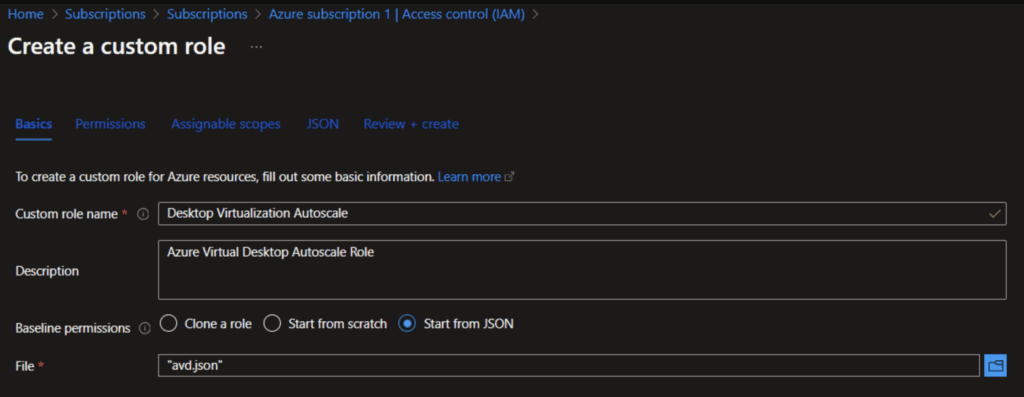

In the Section “Assignable scopes” we need to select our subscription so that the AutoScale will be active for all host pools


After we created the new custom role for AutoScale we need to assign this permission the azure virtual desktop service in azure.


Select the Azure Virtual Desktop Service Account
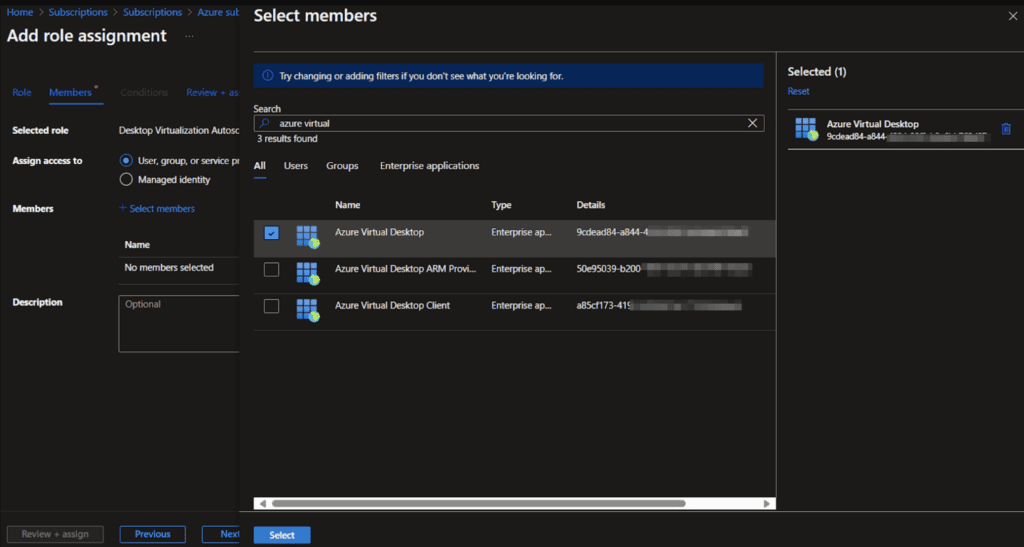

After the permission is available, we need to create a scaling plan on the Host Pool section in the azure portal.
In the search bar type “Azure Virtual Desktop” and select “Scaling Plans” and then “Create”
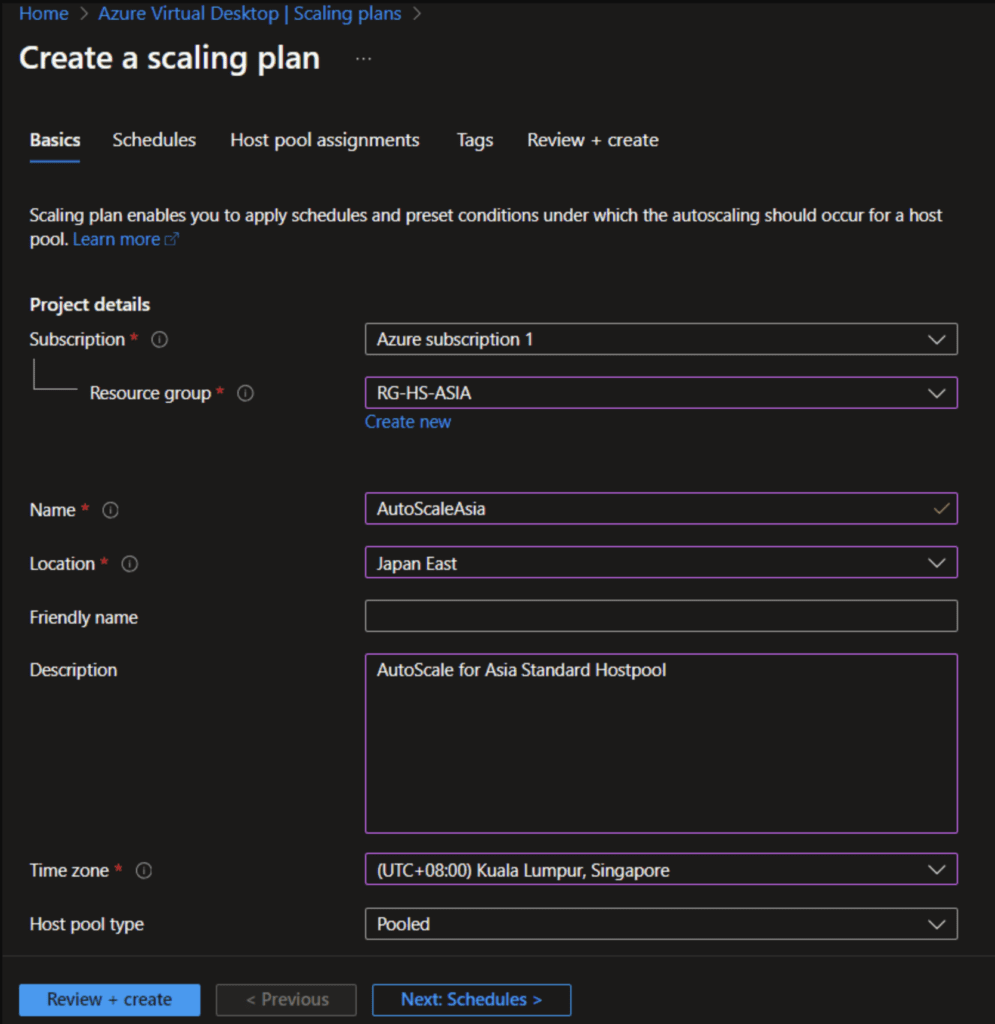

In the first section we need to configure the basics like name and Time zone for the scaling plan. After the basic configuration we need to configure the schedule.


After the Scaling we need to assign the new scaling plan to our host pools
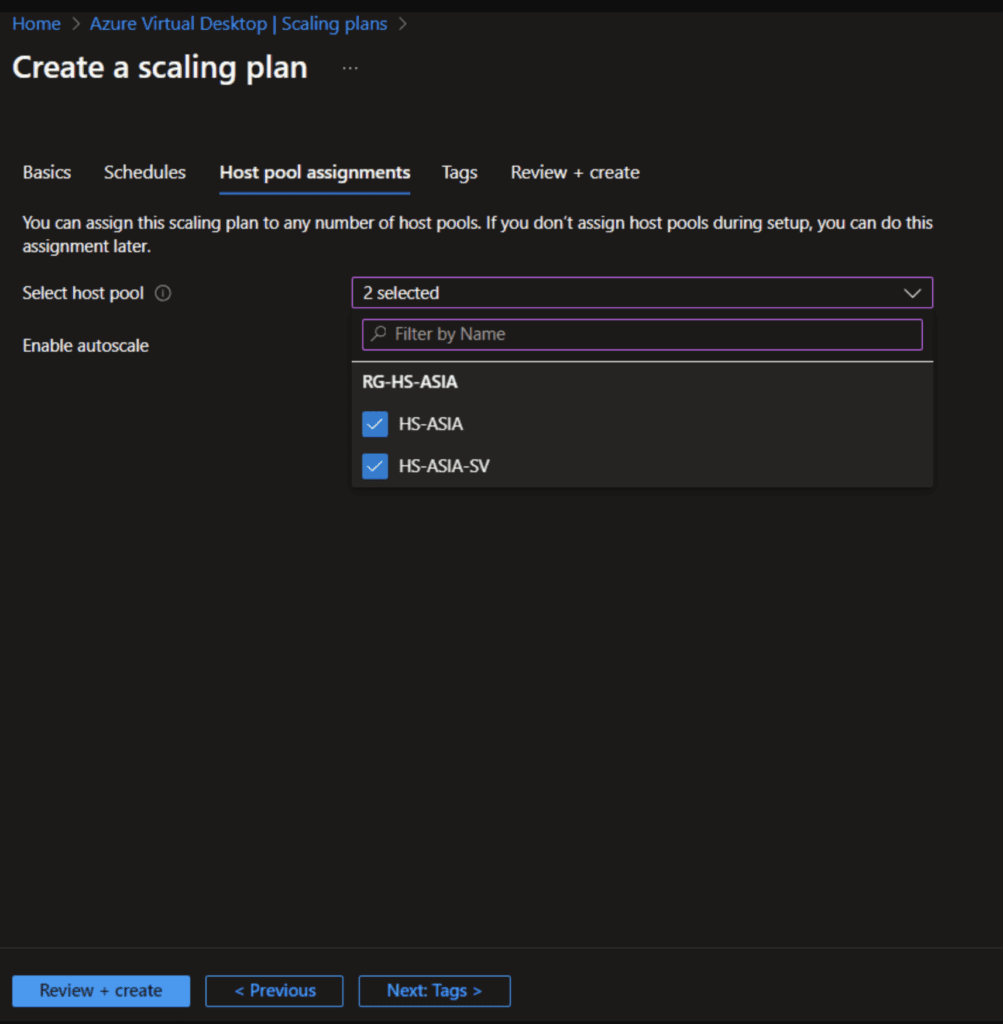

Go ahead and complete creation of the scaling plan.
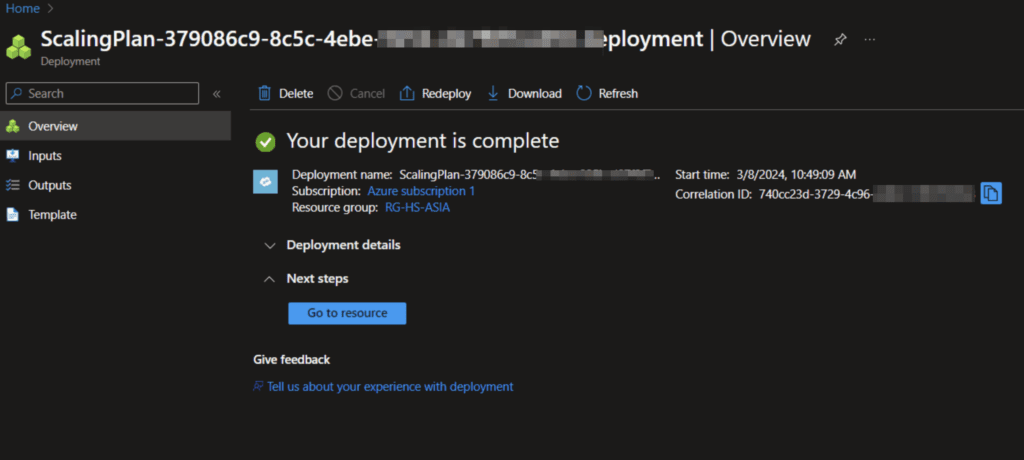

We Can view or modify our existing Scaling plans in the “Scaling plans” Section under “Azure Virtual Desktop”.
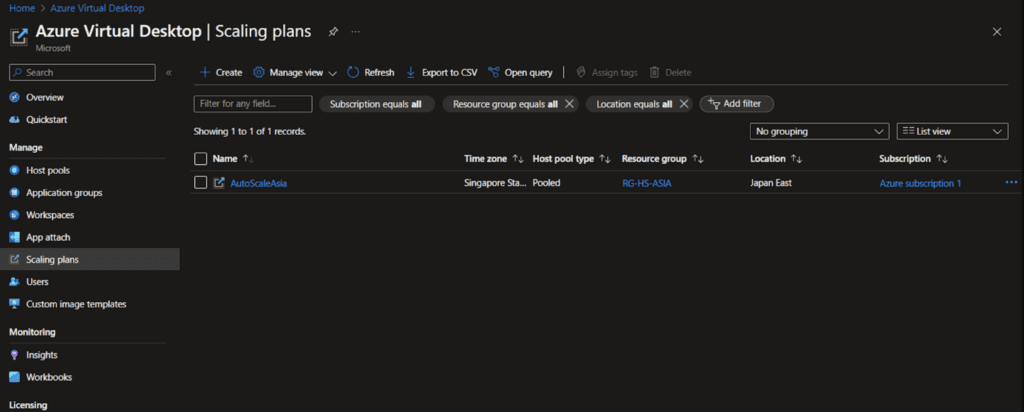

Optional Azure Virtual Desktop setup for BPOs
We had two more requirements from our management to accomplish:
- Ability to monitor agents in stealth mode. Meaning for supervisor to be able to monitor agent’s remote desktop session at any time and without agent knowing he/she is being monitored.
- Record and report on agent access times. This is in relation to simplify workforce management and to quickly report on how many hours agents worked and whether that start and end their shifts on time.
To solve both we could use Teramind Behavior Analytics system. It is inexpensive and very powerful. It provides everything an organization needs to Capture, Analyze and Control User Desktop Activity For Any Use Case.
But because we had a bunch of nerds on our team we decided to use RDP Shadow and Windows Evens to solve the two.
For RDP shadow to function properly same local administrator (username/password) must existon each virtual machine/session host.
You will also need to execute this PowerShell script to allow RDP Shadow with full control:
reg add "HKEY_LOCAL_MACHINE\SOFTWARE\Policies\Microsoft\Windows NT\Terminal Services" /v Shadow /t REG_DWORD /d 2
You also need to understand these windows commands:
qwinstato get the user´s session id (can be run on remote powershell or azure portal on machine -> run command -> powershell script
Finally here’s the command to RDP shadow a virtual machine:
runas /user:<user> "C:\Windows\System32\mstsc.exe /shadow:<session> /v:<ipaddress> /control /noConsentPrompt"<user> needs to be the local administrator of the virtual machine
<session> needs to be the session id of the user /control and to which you have admin permission
<ipaddress> IP Address of the remote machine you would like to shadow.
/noConsentPrompt allow shadow without user interaction.
Use Run Command inside the Azure Portal to run a powershell script


To get the IPv4 Adress you can also run ipconfig or get the IPv4 from the portal within the section “virtual machine”.
After the session ID and IPv4 address we must run cmd with administrative privileges on the Supervisor Virtual Desktop to be able to monitor other users session. Enter the password for the local machine to open the connection.


After we enter the credentials for the local admin a new window with the session of the user will pop up.


To solve the requirement of reporting back to the main office log in and log out events for our agents we used Event Viewer Task scheduler to react and report login and logout events.
<QueryList>
<Query Id="0" Path="Microsoft-Windows-TaskScheduler/">
<Select Path="Microsoft-Windows-TaskScheduler/Operational">
*[EventData[ (Data='\MoveEDIFiles')]]
and
*[System[(EventID=101 or EvendID = 103 or EventID = 104 or EventID = 130 or EventID = 204 or EventID = 205 or EventID = 305)]]
</Select>
</Query>
</QueryList>We will be publishing a new article on how to accomplish this easily.
Amazon Workspaces Web Step by step setup
If you have not yet created your AWS account, start your trial here.
Step 1: Configure VPC
Amazon Virtual Private Cloud (Amazon VPC) gives you full control over your virtual networking environment, including resource placement, connectivity, and security.
Login to the AWS web console to start the creation of a new VPC. https://console.aws.amazon.com/
Enter the VPC service in the search field inside the aws console and click create new VPC.
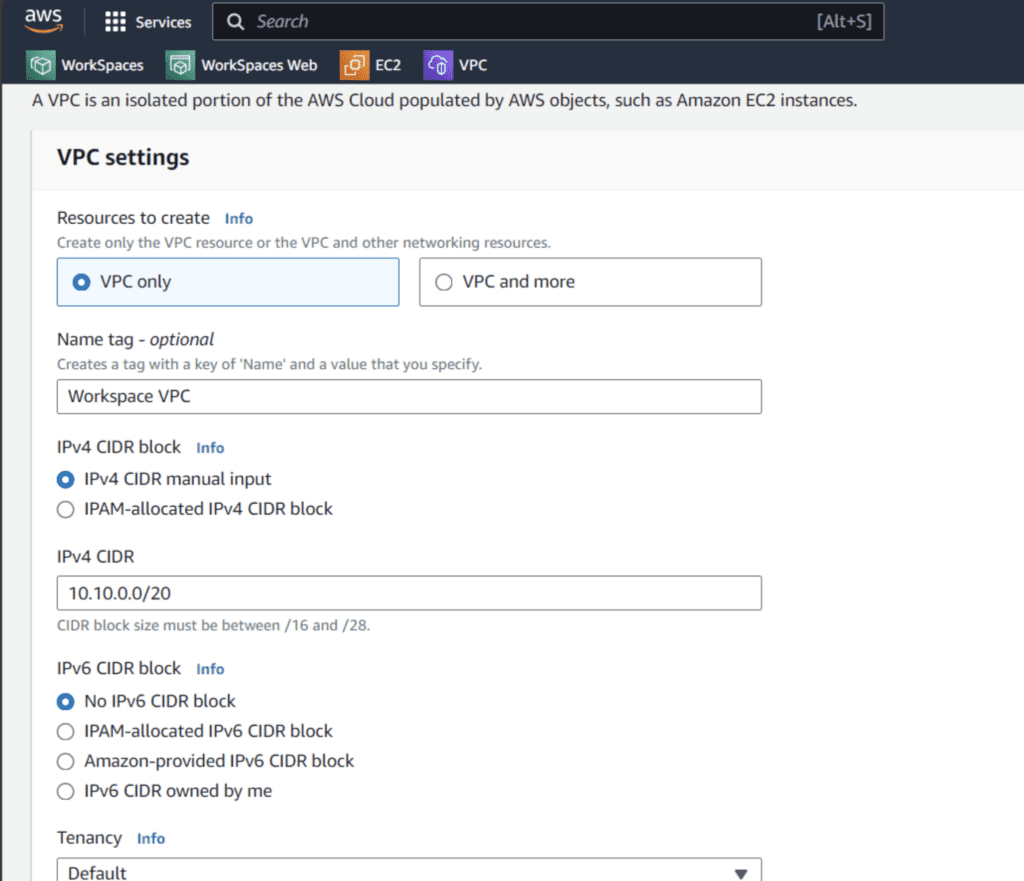

Choose VPC only and user for the IPv4 CIDR the address 10.10.0.0/20. In the Tag section you can set a name for the VPC.
Create two private subnets for the VPC
After the Creation of the VPC we need to create two private subnets and one public subnet for the requirements for aws workspace web.
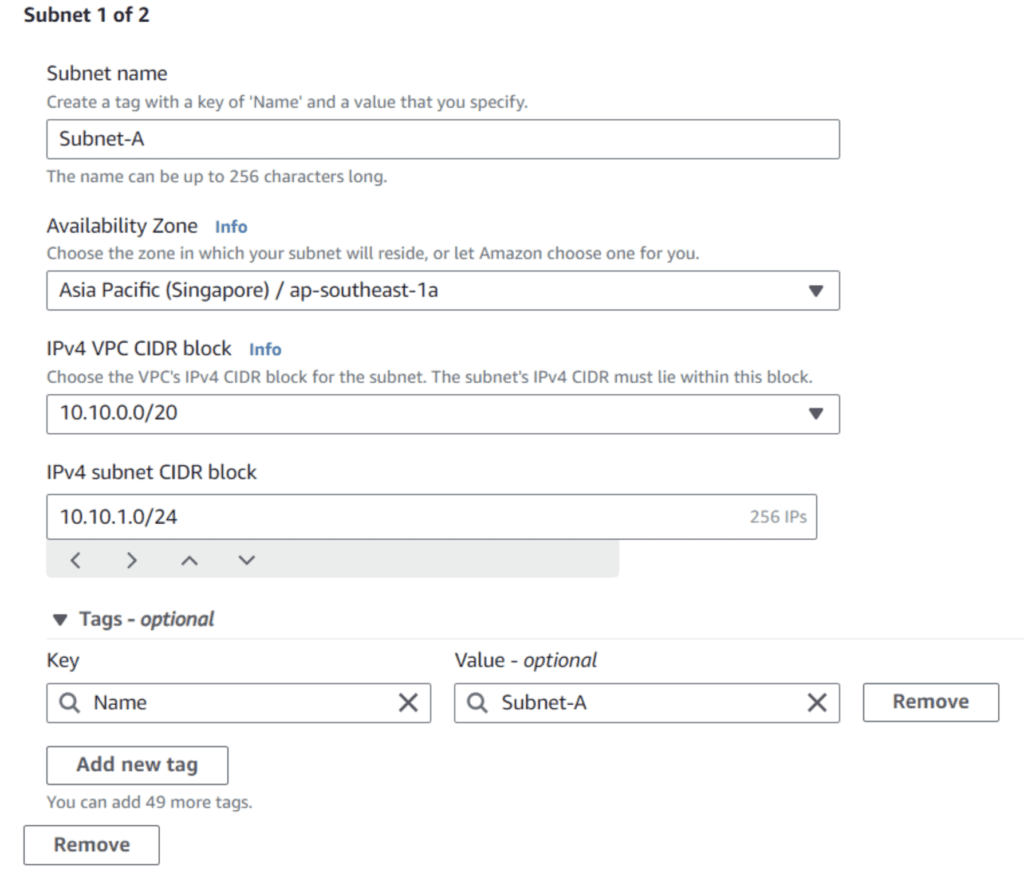

Create a private Subnet-A with IPv4 CIDR 10.10.1.0/24


Create a private Subnet-B with IPv4 CIDR 10.10.2.0/24.
The third subnet will be a public subnet for internet access with an internet gateway where the nat-gateway can be routed to.
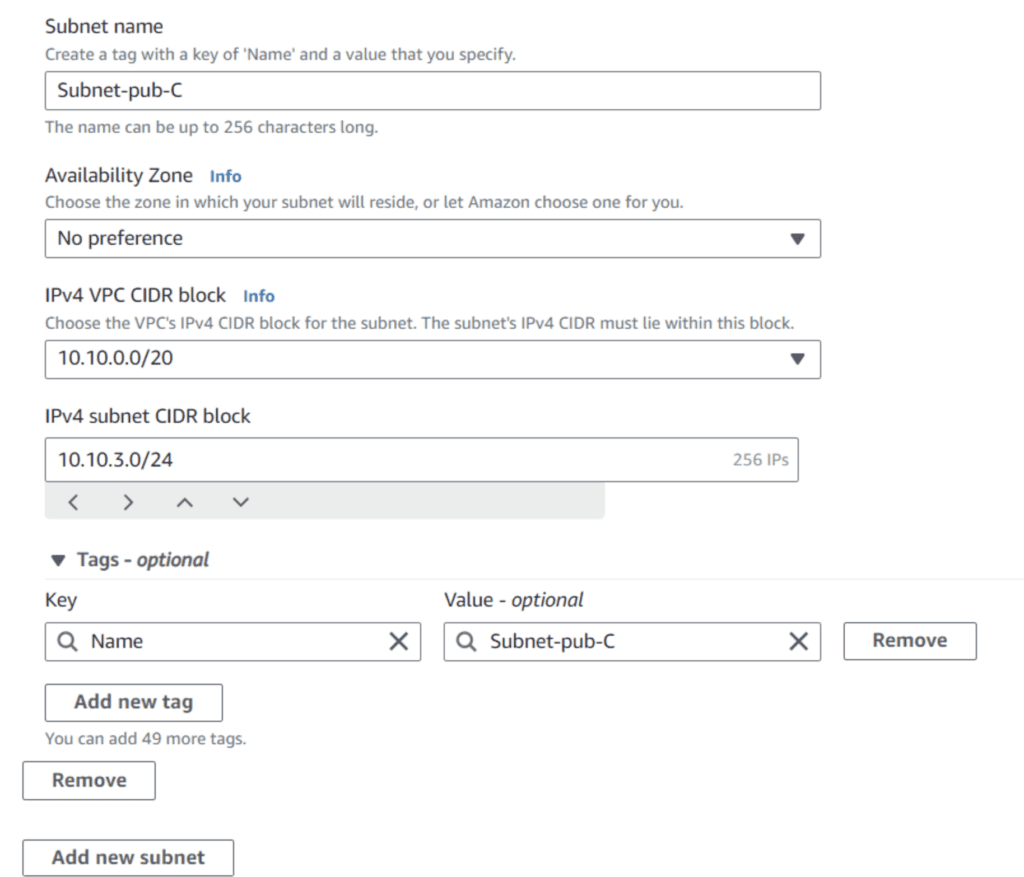

For the third pub.ic subnet use the CIDR 10.10.3.0/24
After creation of three subnets create an internet gateway for subnet pub c for public internet access.
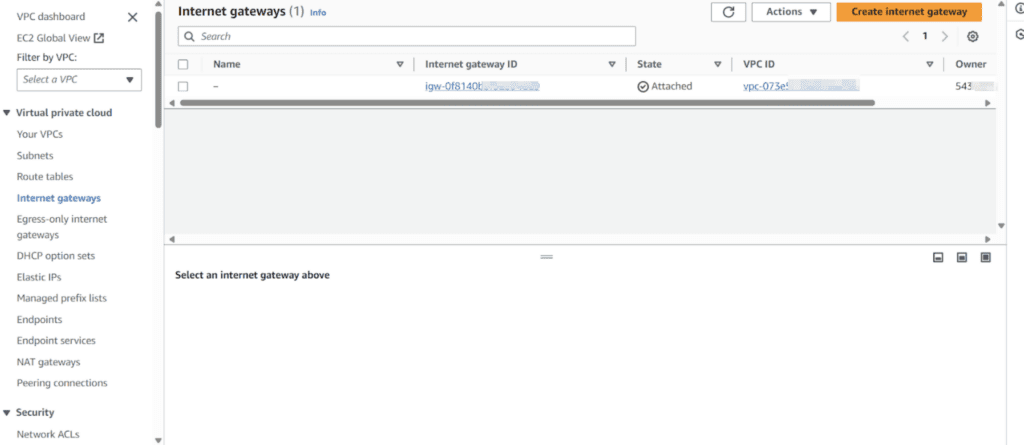

After the creation of internet gateway we need to create two route tables one for the private subnets and one for the routing of the public subnet.


Begin with the creation of a new route table for private routing in the subnet A and B.
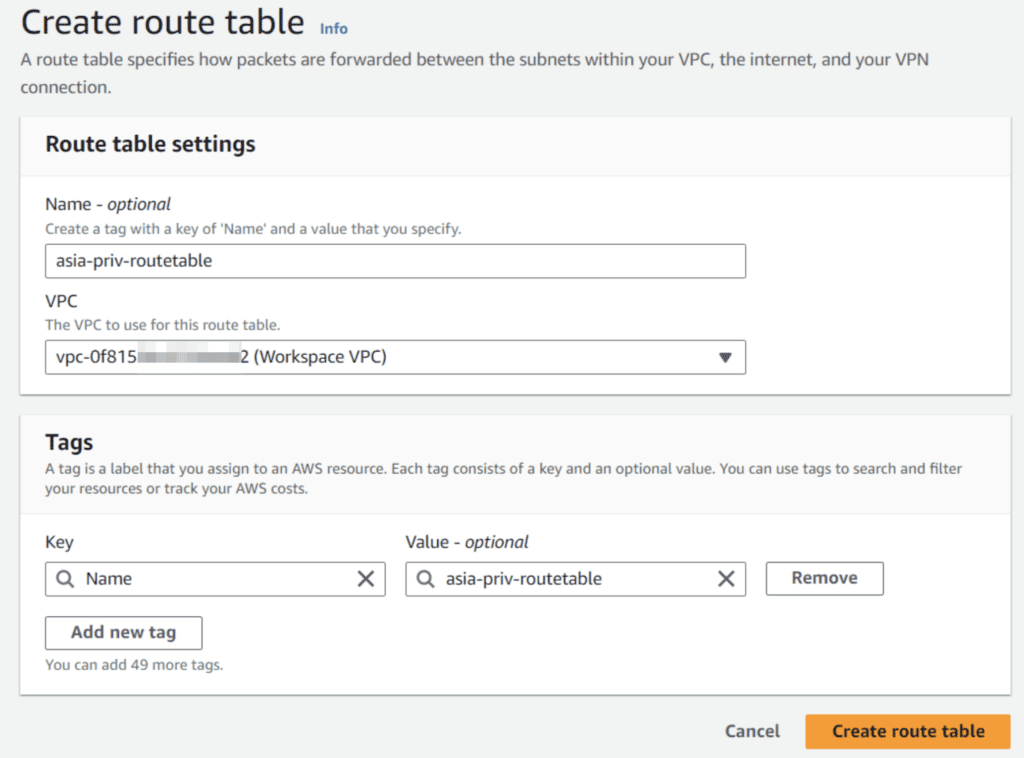

Next create a route table for the public subnet with public routing.
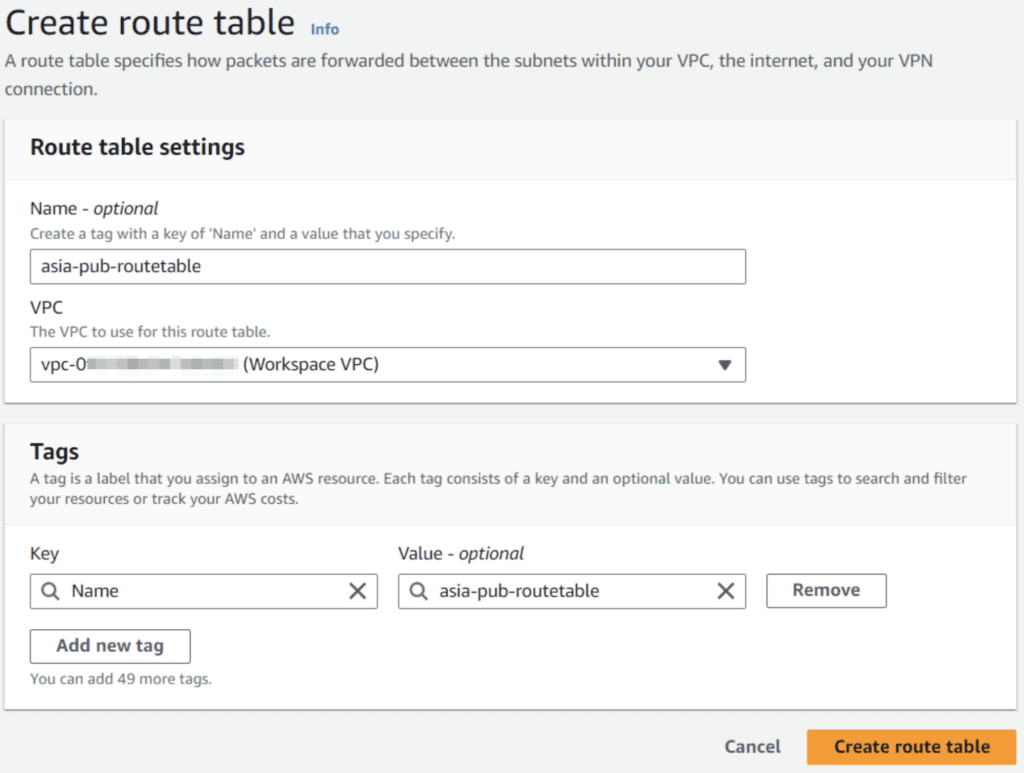

After the creation of the two routing tables we need to attacht the internet gateway to the vpc and the public subnet.
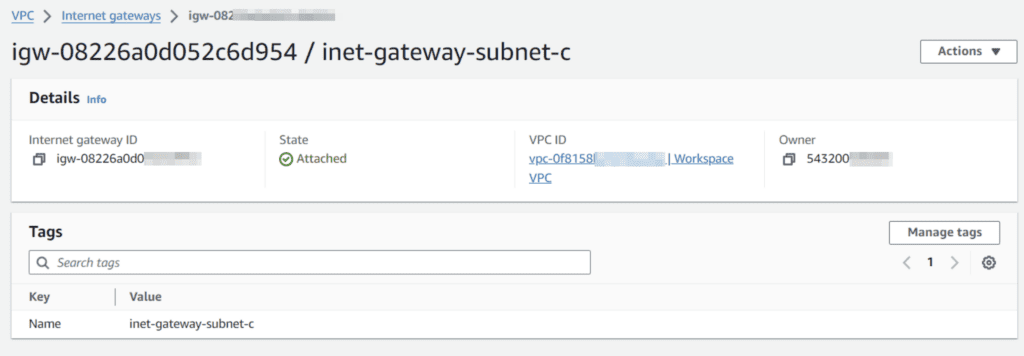

Associate public route table to public subnet in the aws portal.
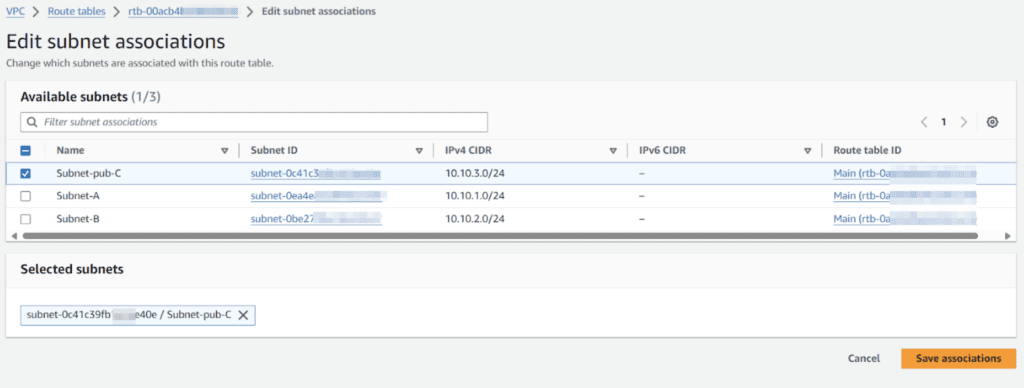

Add route 0.0.0.0/0 for internet to public internet gateway


Associate private route table with private subnets.


Next step create NAT gateway in public subnet so we can route the private subnets trough the public subnet.
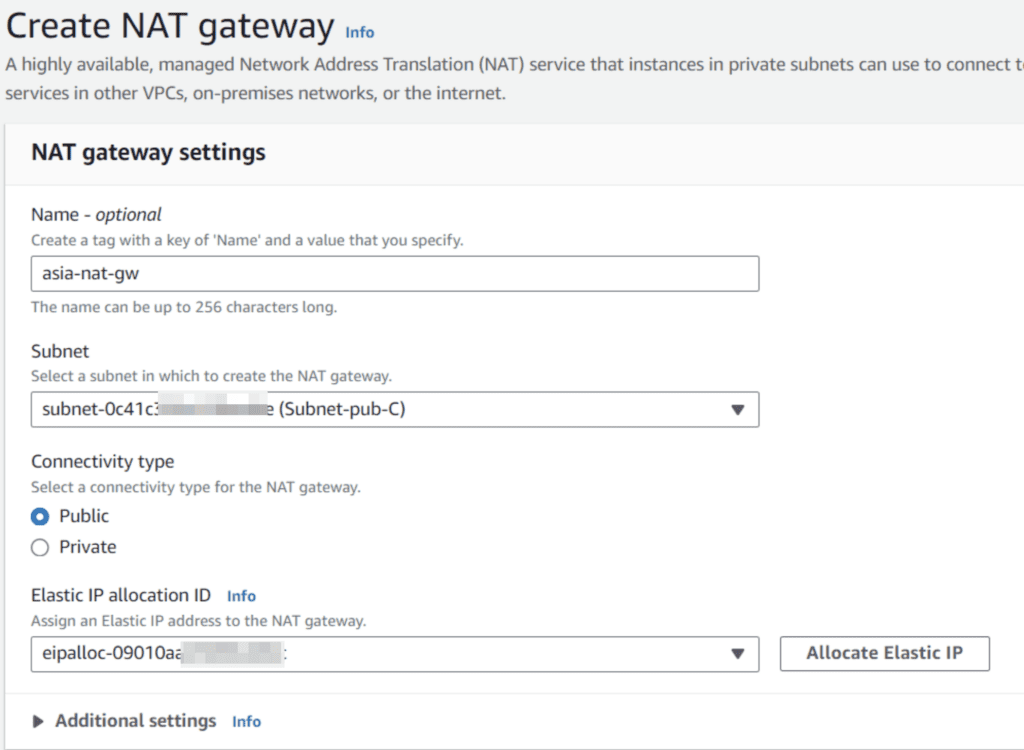

Create a NAT Gateway with a elastic ip inside the public subnet.
To Allow traffic to the intenet we must configure inbound and outbound rules for http(80) and https(443).


After the configuration of the Security Groups we can start to create the web portal.
Step 2: Create AWS Workspace Web – Web Portal with internet access
Inside the AWS Console search for aws WorkSpace Web and click create Web Portal
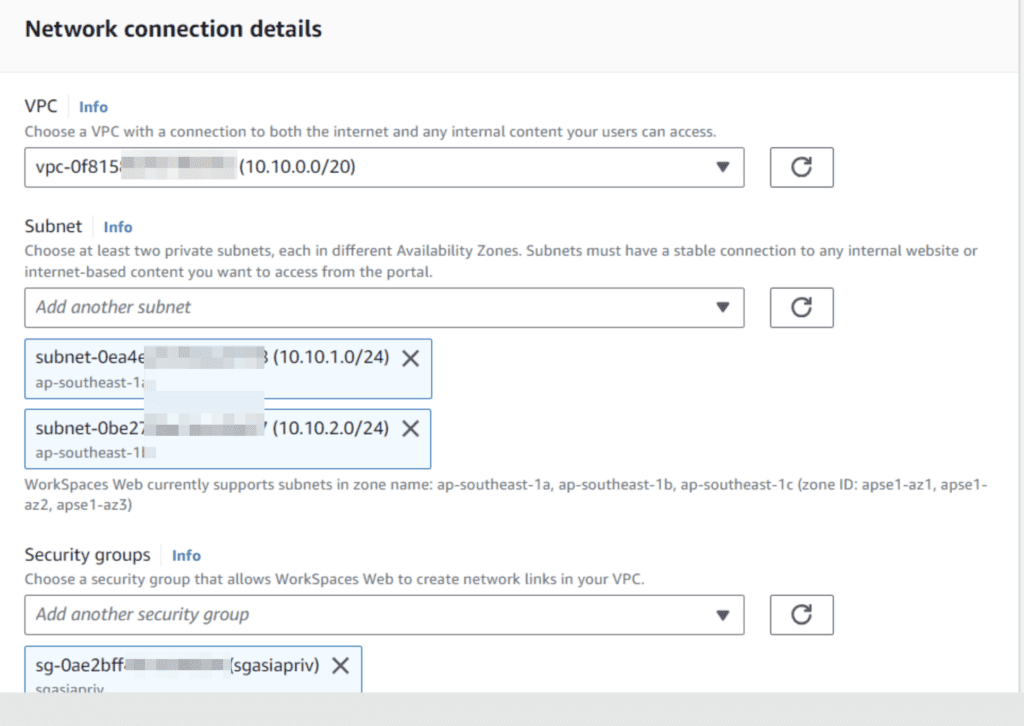

Select the VPC with the two private subnets and the security group for the web portal.
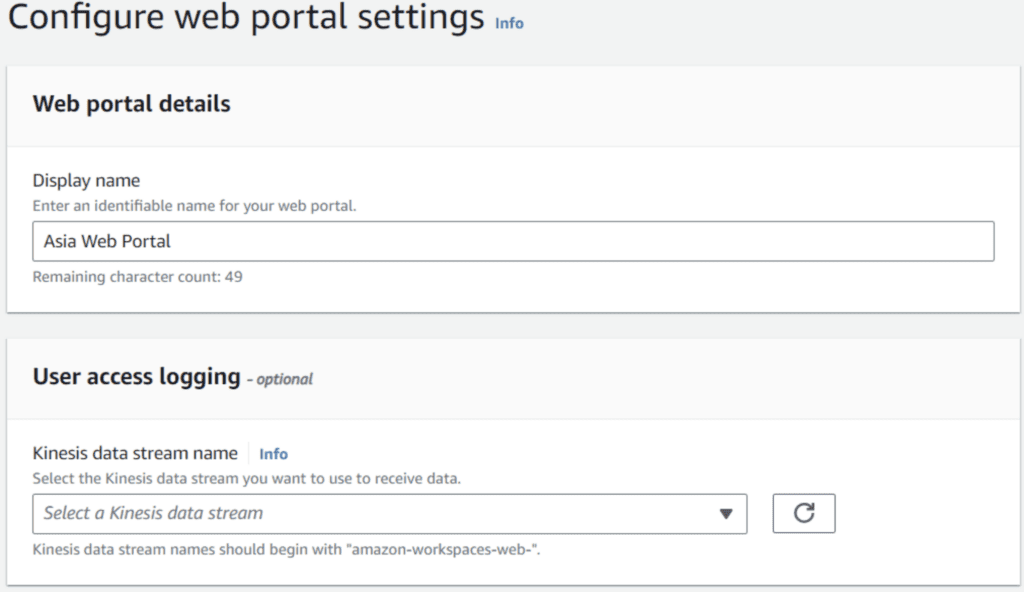

Change the name of the web portal the rest of the settings can be left as the default settings.
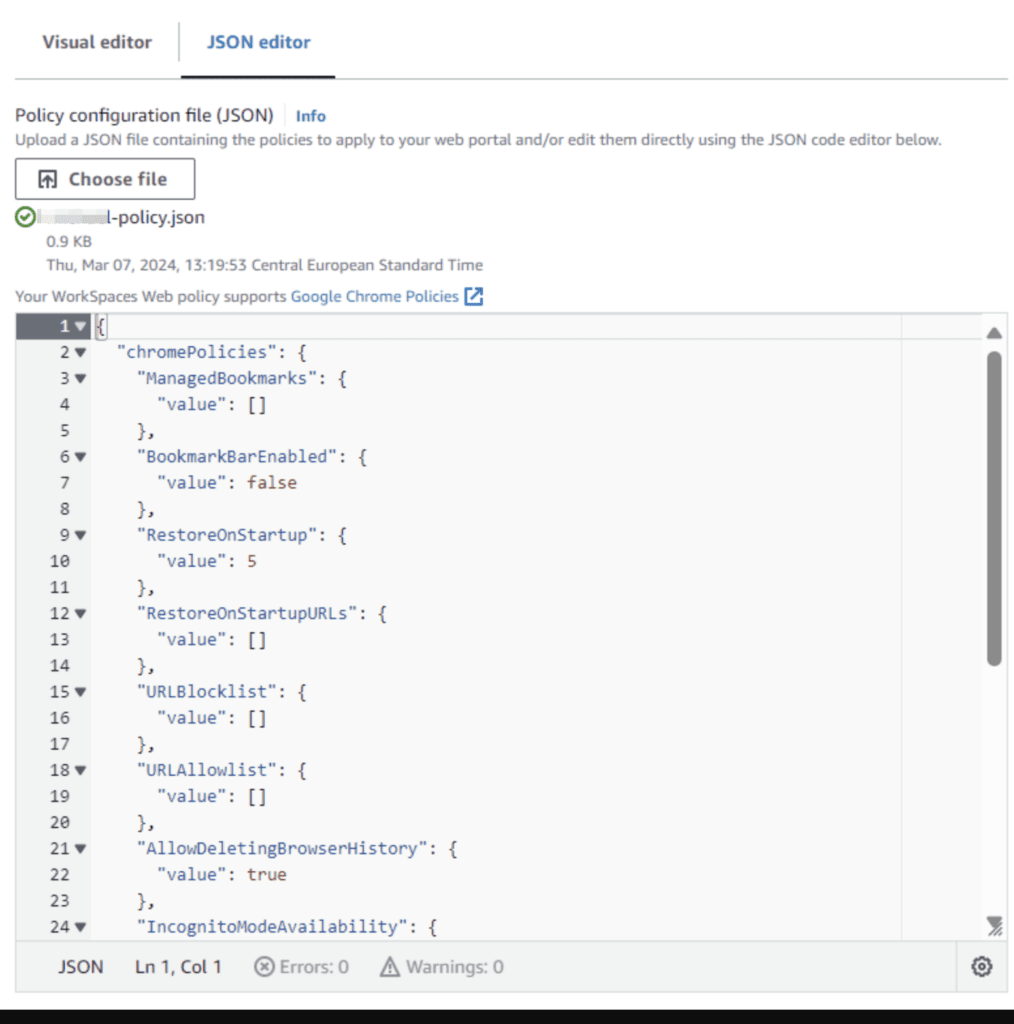

For the configuration of settings and plugins use the json editor to add settings and plugins. This is where you may control what bookmarks, extensions, whitelist and blacklist URLs, copy and paste permissions and other settings to make sure HIPAA or PCI compliance for your BPO.
Test web portal with internet access and all of the settings you configured.


Get Chrome Extension Plugin ID to add to the JSON configuration
Install the chrome plugins on your PC and navigate to chrome://extensions
Select the plugin to get the plugin ID.
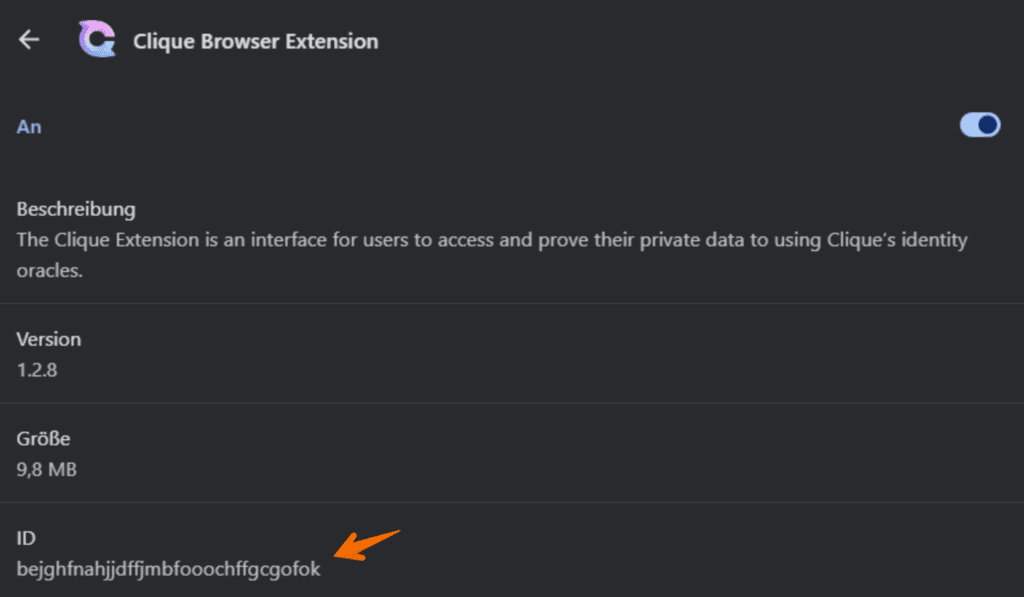

Copy the ID and add it to the json configuration file for chrome.
"ExtensionInstallForcelist": {
"value": [ "ahiickjmnblnnhjcomiegpdikaboegda;https://clients2.google.com/service/update2/crx", "hdokiejnpimakedhajhdlcegeplioahd;https://clients2.google.com/service/update2/crx", "jiihcciniecimeajcniapbngjjbonjan;https://clients2.google.com/service/update2/crx", "oiiaigjnkhngdbnoookogelabohpglmd;https://clients2.google.com/service/update2/crx",
"kbfnbcaeplbcioakkpcpgfkobkghlhen;https://clients2.google.com/service/update2/crx",
“bejghfnahjjdffjmbfooochffgcgofok; https://clients2.google.com/service/update2/crx”]
}Your setup of AWS Workspaces Web is now complete. I recommending to give Security in Amazon Workspaces Web a read to learn more.
Finally make sure to understand all of the monitoring options available to make sure they are inline with your requirements.
Conclusion
In summary, building the Virtual Desktop Infrastructure (VDI) for Business Process Outsourcing (BPO) companies needs a well-planned and configured approach. Azure Virtual Desktop or Amazon Workspaces Web, both provide many features and benefits for remote IT management. Azure Virtual Desktop delivers the complete virtual desktop experience, which is perfect for businesses that have a wide range of software requirements. Conversely, Amazon Workspaces Web provides a protected chromium web browser environment perfect for organizations which are mostly using web-based applications.
Moreover, enabling AutoScale for Azure Virtual Desktop and deploying AWS Workspaces Web portals also requires extra settings for best performance and security. With the knowledge of the configuration of VDI solutions, customization of user profiles, and the use of monitoring tools such as RDP Shadow, and Windows Events, BPOs can effectively manage their IT systems for remote staff. In my opinion, a careful Azure VDI setup will improve the productivity, security, and compliance of the organizations that are managing the remote workforce in an organized manner.



